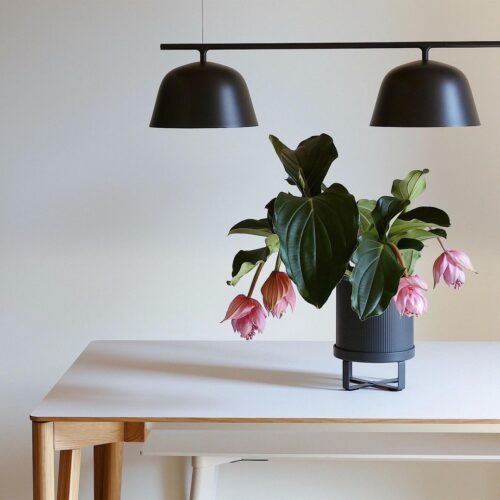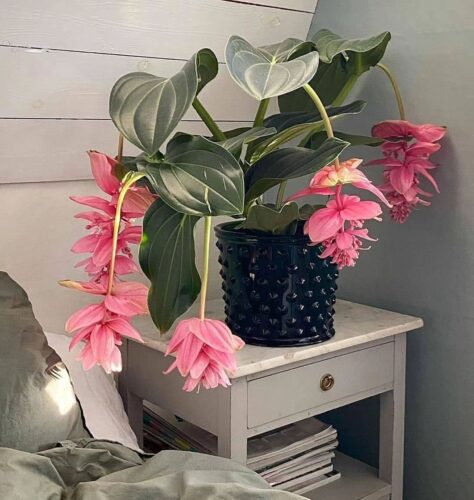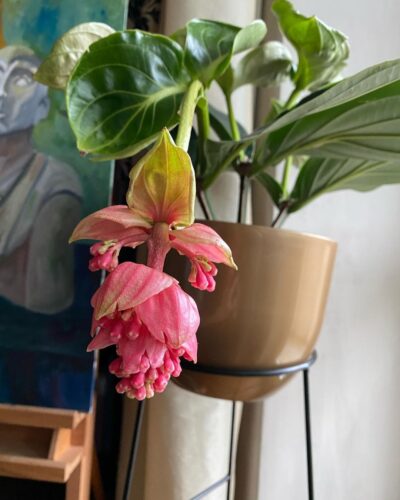Medinilla Magnifica can be a beautiful addition to your Indoor garden. Follow the guide below for the best care and growth.
Grow Medinilla Magnifica in your home garden and witness beautiful pink blooms hanging down beside leathery green foliage. Read the article below for the best tips and tricks.
Read: How to Grow Chinese Croton Indoors
Medinilla Magnifica Profile

Native to the Philippines, Medinilla (Medinilla magnifica) is related to the Melastomataceae family. In tropical habitats, this plant grows epiphytically on trees and on ground. This evergreen shrub produces dark green leathery leaves with deep veins. It offers clusters of dangling pink blooms between February and August. When pollinated, the plant produces ornamental berries with pits.
Read: How to Grow Crocodile Fern Indoors in Pots
How to Propagate Medinilla Magnifica
Propagation of this plant is slightly difficult, so purchasing young plants is advisable. However, you can try growing Medinilla Magnifica from stem cuttings.
- Take 4-6 inches of non-woody stem cuttings from a healthy plant in the fall or spring after flowering.
- Dip the stem cuttings in rooting hormone, though it is optional.
- Plant the cuttings in a sphagnum moss.
- Keep the pot in a warm place with humid conditions. Cover the cuttings using a plastic bag to maintain humidity.
- The required temperature near the roots has to be 86-95 F; you can achieve this by using a heating mat.
- Around after 4 weeks, the roots will develop.
- Transplant the cuttings to a 10-12 inch pot filled with well-draining soil.
NOTE: You can also propagate this plant from seeds and air layering.
Read: How to Grow Piper Ornatum Indoors
Ideal Growing Conditions for Medinilla Magnifica Indoors

Light
Keep the potted plant where it gets bright, indirect light away from direct sunlight. Light shade will be ideal for this plant as it flourishes in the canopy of tropical forest.
Soil
Use humus-rich, permeable, slightly acidic soil. Layer the bottom of the pot with shards of clay or pebbles while planting to improve drainage.
Water
Keep the plant moist throughout the growing season, and drain excess water from the saucer after 15 minutes of watering. Use room-temperature water, which must be lime-free. In the dormant season, water the plant less by just keeping the root ball moist and avoiding letting it dry out entirely.
Temperature and Humidity
The suitable temperature for this plant has to be between 65-75 F. During winter, it can be a bit cool as Medinilla magnifica requires some rest to form flower buds. Remember that, even in that duration, the temperature won’t fall below 59 F.
This plant appreciates at least 60 percent humidity; you can improve it by using a pebble tray filled with water.
Read: How to Grow Hoya Mathilde Indoors
Medinilla Magnifica Care Indoors

Fertilizer
As this plant blooms for months, it requires lots of nutrients. Feed your plant with liquid fertilizer once a week in the growing season. In winter dormancy, stop feeding your plants.
Repotting
When the plant outgrows the pot, move it to an 1-2 inches bigger container before spring without damaging the root ball.
Pruning
Pruning is not essential, but you have to remove withered blooms to expand the flowering period. Eliminate dead and yellow foliage. To encourage flowering, trim the shoots by half of their length. You can cut back the woody shoots during spring to promote the growth of new shoots and boost branching.
Pests and Diseases
Spider mites, aphids, and scale insects can damage plants. You repel these pests by maintaining humidity. Use neem oil or insecticidal soap to treat the infestation.
Root rot may trouble your plant; it arises due to overwatering. You can overcome this issue by growing Medinilla Magnifica in well-draining soil. Fungal diseases can be avoided by retaining good air circulation. Moreover, check the leaves frequently for hints of pests and diseases and handle them instantly for a healthy plant.



